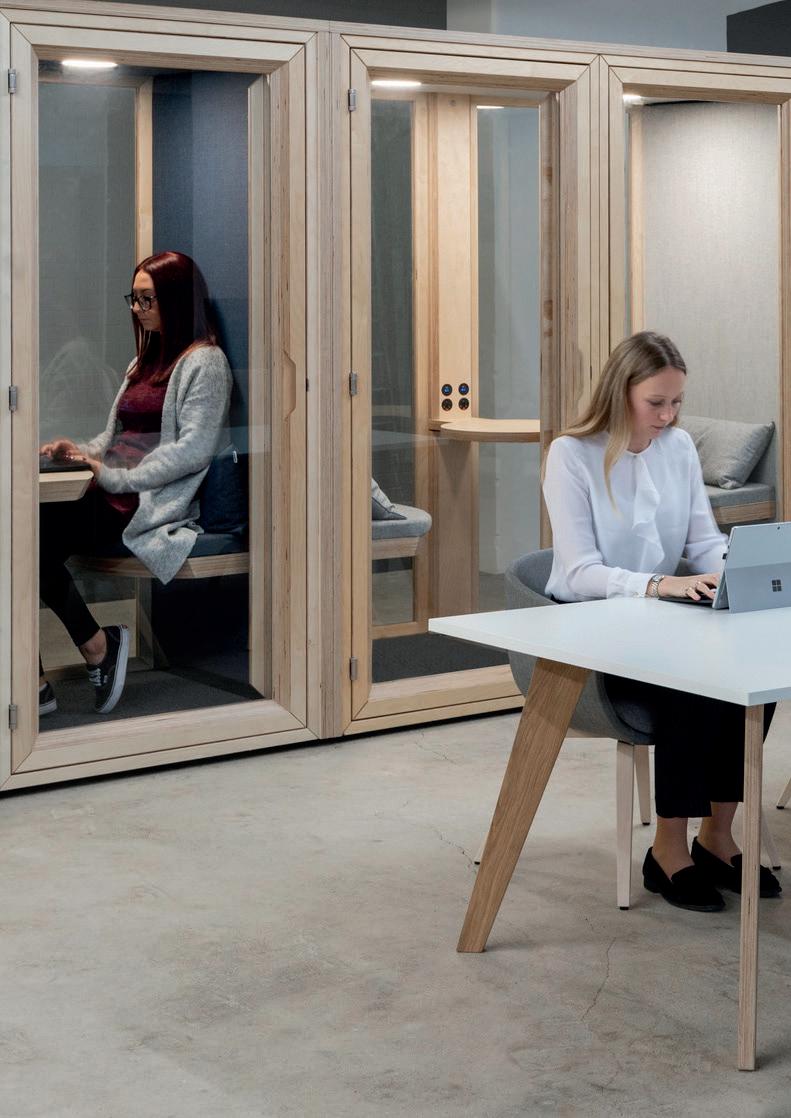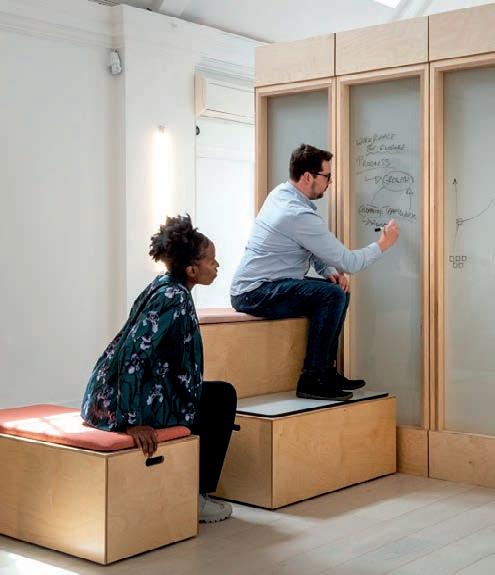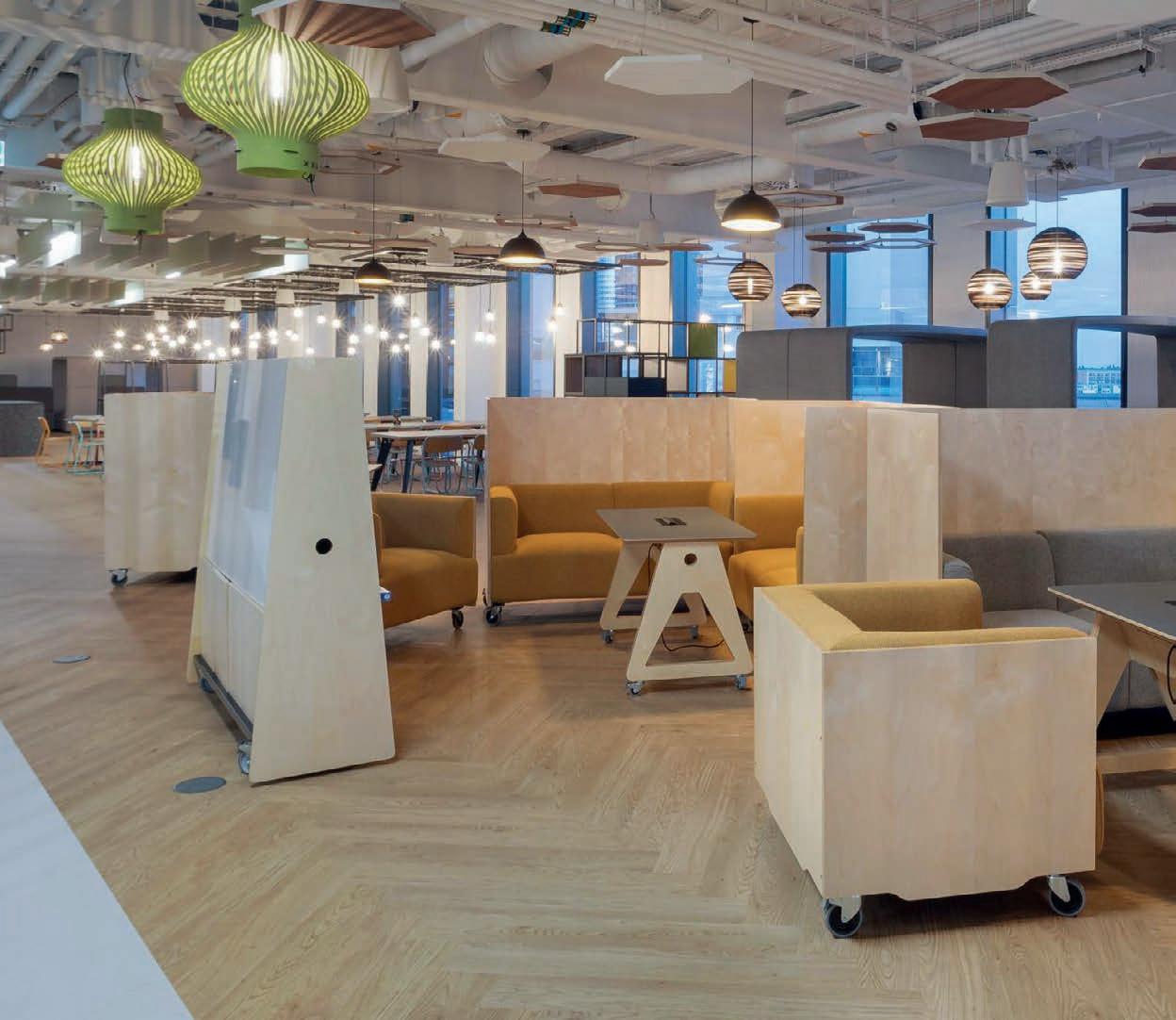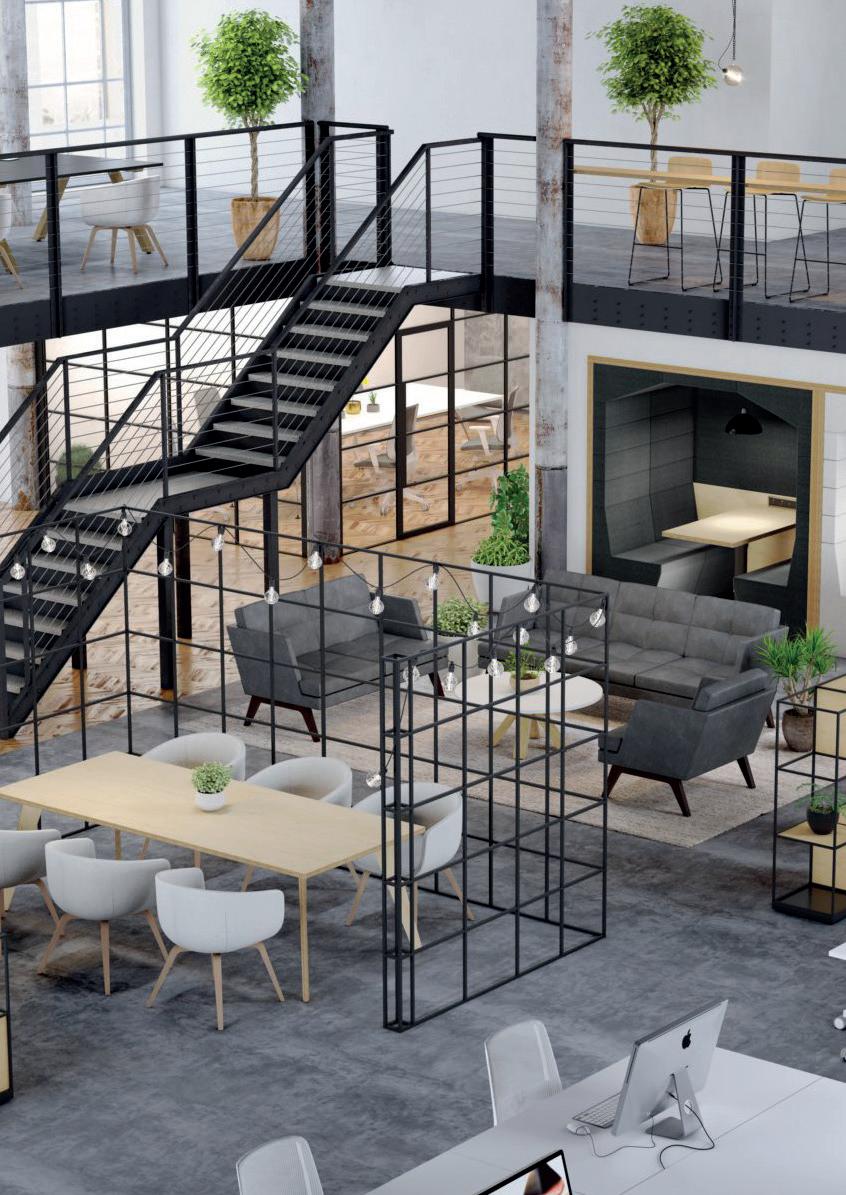Transform your business with
















The events of the pandemic have focused minds once again on the role of the office, and how it can most effectively support people to do their best work.
The last two years have opened the eyes of organisations across a breadth of industries to the possibilities of different ways of working, with remote and hybrid working being pushed up the agenda. The role of the office has changed, and this shift in where and how people work has opened up opportunities to think differently about how that space is best utilised.
The traditional workplace system of designated desks and inflexible, ill-equipped meeting rooms is clearly no longer fit for purpose. This has been driven in part by the pandemic, but there are other factors that have influenced shifting attitudes as well.
Businesses have started to tune in to the untapped potential of the workplace, and the benefits of adopting a more dynamic approach to workspace design. Workplace leaders are seeking to remove obstacles that limit productivity, by reshaping the workspace to provide employees with a range of activity-based spaces that are tailored to the specifics of the work they carry out.
These changes are driving individual and team performance and enhancing collaboration. With the ability to choose where, when, and how they work, employees thrive as activity-based working (ABW) makes it easier for employees to fulfil their roles. This benefits the businesses that opt for more modern working models exponentially. Finding actionable workspace solutions that reform the way the workplace operates has therefore become a focal point for many businesses.
The recent surge in alternative ways of working such as hotdesking and hybrid working has gone some way towards meeting these demands. We know employees are no longer willing to come into the office for the office’s sake, only to be met with a system that no longer works for them. This has led to a majority of UK office workers feeling discouraged with the workplace, with 60% stating they’d rather work remotely all the time. To keep businesses connected, productive, and with thriving employees, we need to look at new ways of working.
Activity-based working addresses this demand. It brings a performance-focused approach to the idea of the workspace on various levels. It benefits businesses by optimising productivity and business performance, while rationalising the associated property costs of having an office. ABW is being adopted by a range of organisations looking to support their employees with the best possible workspaces, designed in ways that will empower them to do their best work. Reducing costs while improving employee performance, the businessrelated benefits of ABW are undeniable.



Activity-based working focuses on the idea that each location within an office should function to suit a different work-based activity. Rather than the classic office layout featuring regimented desk allocations for everyone, activity-based working understands employees benefit from having multiple tailored environments to work from. The scope of tasks each employee is required to undertake within the span of just one day means they’re subject to ever-changing demands – yet we’ve been providing them with exactly the same workspace throughout.
ABW understands how limiting someone to one designated workspace can also limit the way they perform. It’s about addressing the restrictions caused by typical workspace dynamics and working to change them. ABW is about using innovation to adjust our spaces to suit the way we work – not the other way around.



The revival of the office Activity-based working is not a new concept, though its popularity only started to really gain momentum in recent years. The term was devised after Dutch consultant Erik Veldhoen’s 1994 book ‘The Demise of the Office’, which went on to inspire a range of activity-based working projects. Veldhoen recognised how a changing world required changes to the office environment, particularly with regards to the advances being made in workspace technology.
Today, the increased digitalisation of office-based tasks means businesses are no longer ‘stuck’ with the confines set out by traditional office layouts and settings. Companies are latching on to the idea that a more dynamic approach is the best route for increased business performance.
As we see more offices adopting activity-based working, we expect to see an increased number of businesses thriving as employees return to (and become satisfied within) the office. While recent events have diminished the role of the office from the perspective of employees, the office remains an integral factor in enriching company culture and performance for any business. As activitybased working is now being introduced to the mainstream, the revival of the productive and creative workforce is here.

Activity-based working is not only an innovative way to design offices. It’s an entirely new model of working, with the design of the office adapting to encourage this new approach.
The idea behind activity-based working is that re-designing our work environments to optimise employees’ abilities will benefit business. This contrasts with the typical approach of implementing a top-down working model, and expecting everyone to follow suit.
Activity-based working is best implemented when you optimise the entire design of each respective workspace to suit the activity it’s intended for. Done effectively, this means the ideals behind ABW can be implemented successfully, boosting business performance and employee satisfaction.
Offering a range of different environments your workforce can utilise throughout the day enhances the flexibility of the workplace. Individual desk spaces are no longer expected to cater for such a wide scope of activities, so workers are no longer expected to adapt their surroundings to suit their projects. Instead, the activity-based workspace offers a variety of surroundings that allow employees to seamlessly move from one task to another. They can do this without wasting time clearing up their desk, moving task-based equipment between areas, or even using up mental effort in psychologically gearing themselves up for the next task despite remaining in the exact same space as before. Productivity increases, and business performance is optimised.
The question ABW asks is, essentially, does the traditional workspace still work for us?
Classic office elements like desks play such an integral role in our typical workday that it can be difficult to imagine different office setups with alternative designs.
Despite this, Gallup Chairman Jim Clifton estimates that 37% of office desks will remain empty despite large numbers returning to work throughout 2022. This suggests that the way we’re working is evolving so much, our office environments should also follow suit.
ABW does not advocate for the abandonment of classic aspects of the office. Solo work is still necessary across a range of situations. The solution is to switch to a more efficient means of providing workspaces, such as hotdesking, hotelling, and neighbourhoods. This saves space in reducing the number of unused desks, providing opportunities to design more functional areas within the office that suit the modern workforce.
of office desks will remain empty in 2022
Some may feel disheartened at the idea of losing their individual workspace, as it’s a dedicated space employees can claim ‘ownership’ over within a building that may contain thousands of employees. However, the enhanced degree of control and customisation an employee has within a dynamic ABW environment certainly makes up for this.

This means creating a series of carefully considered work environments that each suit different workday activities, while also instilling this sense of flexibility within your workforce. ABW offers a compelling range of benefits for businesses when implemented effectively:




Activity-based working involves optimising the design of your office to suit the range of activities your workforce undertakes.
Businesses that adopt an ABW-led office strategy report enhanced collaboration between teams and individuals. By providing spaces that promote better communication and teamwork, as well as supporting concentrated individual work when needed, the organisation sees dramatic improvements in productivity, effectiveness and ultimately business performance..
Performance improves when businesses provide employees with workspaces that work for them. ABW increases workforce productivity and performance by making it easy for your people to carry out the variety of tasks their day requires. This leads to increased employee satisfaction and engagement, making the office a more effective hub for your business.
Space utilisation involves optimising the space you use to maximise its impact, removing underutilised and inefficient space and rationalising your property costs. Activity-based working moves us away from over-reliance on the individual desk – which research shows are only utilised for 50% of the working day – and re-works the additional space freed up to provide a comprehensive range of workstations, hubs, and amenities for a variety of tasks and activities.
By maximising the flexibility of your office space design and the way it’s used, activitybased working strategies offer a long-term design solution. With a flexible workplace design that can adapt as your business evolves, the business is able to keep refining the space over time. Workplace design consultations can be periodically carried out after you have adopted activity-based working, ensuring your office is continuously optimised to achieve the best results for years to come.
From a health and wellbeing perspective, increasing opportunities for employees to move around the workplace can have a profound positive impact. Office employees are traditionally used to spending all day at their desks, which can have a negative impact on energy levels and concentration among other things. Solutions such as the standing desk and the treadmill desk can help mitigate these problems, but an office that encourages movement and a different way of using the space is a better way to address the issue at its core.
An individual’s desk is only utilised for 50% of the working day
No two offices that have adopted activity-based working practices look the same. This is because each organisation has individual needs and unique employees. The layout and structure that works for one office is entirely different to what works for another.

ABW environments feature highly dynamic spaces that encourage more flexible behaviours from employees, too. The ability to adjust workspaces as each activity ensues also gives employees a greater sense of control over their surroundings, promoting wellbeing and job satisfaction. This can foster creativity, bringing more innovative ideas to your business. With multifunctional areas designed to account for a range of activities, modular furniture that adapts to suit each day is popular.

In ABW scenarios, employees are free to move around the office, selecting the working environment that suits their activity best. This leads to higher levels of engagement with colleagues in alternative roles, thus feeding into a stronger sense of community and office culture within the workplace.
Behavioural cues can be key to helping the workforce seamlessly integrate ABW practices into their everyday routine. In activity-based workplaces, you’ll find plenty of signage directing employees to various ‘stations’ within the office. These encourage the effective use of each space, while also prompting the natural flow of employees through the office as they go about their day.
Alongside the general ‘feel’ of an activity-based workspace, there are physical elements that many workspaces benefit from. Offering a diverse mixture of rooms, amenities, lounges and quiet areas ensures there’s always somewhere to suit everyone.
The exact configuration of spaces and amenities will depend on the needs of your own workforce. There is no ‘one size fits all’ approach to implementing activity-based working spaces. The following range of solutions provides a good place to start:
As the prevalence of remote working grows, providing quiet spaces for taking video calls and meetings is vital. These spaces make use of adaptable furniture so space is utilised to its full potential, with quiet areas transforming into focus rooms where in-person, 1-to-1 conversations can happen too.
Conference spaces are still key for meetings, though they’ll be revitalised to serve more than just one purpose. They might contain flexible equipment that transforms the room into a creative studio, or a team-based exercise as needed.
Keeping the workspace comfortable with home-like amenities draws the workforce back into the office. With functional yet aesthetic areas that support the free movement of employees around the office, spaces are less likely to become congested.
In any office, collaboration is key. Dedicated zones for communal work allow employees to communicate and work more effectively together.
Huddle zones for smaller discussions within teams might be dotted around the office, strategically positioned to support the movement of employees as they go about their day.
The classic office cafeteria is not lost. It remains an integral space where meals and breaks are catered for. These spaces can be curated to suit the mood of your office. For example, a relaxed atmosphere where employees can switch off and chat over lunch – taking their break away from their work.
In offices where certain equipment is required across projects, the process can be streamlined with dedicated project rooms that provide everything needed to complete the task efficiently. For example, all the tech required to fulfil tasks within one working space. This means employees won’t waste time traversing the office to find equipment.
The desk is still very much alive and well as a work setting, but with more flexibility for employees to use as and when best suits their work routine. Provision of open-plan desks and individual desks is restructured to account for actual occupation patterns, allowing for flexible working, hotdesking and hoteling.

Activity-based working is a highly flexible way of optimising your office for its intended purpose.
If you’re looking for an enriching office environment that’s been specifically designed for optimal performance and productivity across the wide variety of activities your workforce undertakes in one day, then activity-based working is for you.

Many organisations have already adopted certain models that mimic the key components of activity-based working without realising. While it’s true that this has likely been due to the crucial changes we’ve had to make as the course of the pandemic has evolved, workforces and companies alike have seen plenty of advantages within these changes.
It’s time to question whether your current workspace is really working for you, and what you can do to improve it. For impartial advice on whether activity-based working could benefit your business or organisation, our workplace consultancy services are the first step.
Is it time to question whether your current workspace is really working for you?






The move to activity-based working will only be successful if the process is well thought-through, with a focus on understanding the needs of your organisation and your people, observing actual patterns of activity, and using these to inform the strategy.


with Activity-Based




Designing an office that’s optimised to your people and the work they carry out begins with a robust, evidence-based strategy.
Experienced strategists use a variety of tools to gain a deep understanding of how your business operates and how your space is used. These include occupancy surveys, motion and activity data gathering, mapping the interactions and dependencies of different teams as well as their preferred work styles.
The results of this process inform the blueprint of the needs of your business, and the types and ratios of different spaces needed, as well as their layout.
ABW involves achieving a robust, cohesive office design that’s been carefully tailored to suit your workforce’s needs.
Experienced workspace designers will already be highly familiar with and wellversed in the properties of ABW. They’ll be able to design dynamic work environments that are each tailored to suit different work activities.
In doing this, they’ll be able to devise an office design that works based on how your workforce prefers to work – by applying the results of a robust, evidence-based workplace strategy methodology.
Over the course of the pandemic, businesses have refined the way they utilise collaborative tools, both on and offline. These collaborative platforms and networks, when used effectively, drive the success of flexible and location-independent working.
Many opt to use business conference software like Zoom, or a communication tool that enables the complete integration of the workforce, such as Slack.
The combination of tools that works best for you will be one your whole team can use both efficiently and effectively. Adapting to make the most of these collaborative tools may require some training, if you haven’t already adopted such technology.
There are plenty of options when it comes to office furniture, depending on the style and level of flexibility you’re looking for. Considering ergonomics has always been an integral factor in achieving a well-designed office. With activity-based working, appropriate furniture settings play an increasingly vital role in how well your office works. All furniture should be built to sustain optimal performance for the intended activity it will be used for.
Beyond ergonomics, consider modular furniture that can be easily shifted to transform workspaces to suit new purposes on the spot. Think about how each piece of furniture works on its own individual merits, but also how it interacts with other objects and design elements to fulfil its intended purpose.
Alongside finding the right collaboration tools, devising a virtual working environment that works for your company on a systemic level is equally essential for adopting ABW practices. Your virtual working environment should be cohesive and intuitive when it comes to sharing and uploading documents, hosting meetings, and other workrelated tasks.
It should also be conducive in helping you to monitor work performance. This helps you consider how your virtual working environment works in practice. Survey your team and ask their opinions – keep checking in to ensure there are no issues impacting productivity. What works for one individual may be confusing for another. This means taking an employee-led approach when it comes to productivity can be beneficial. If there are any gaps in knowledge causing these confusions, providing training sessions can alleviate the problem.
Figuring out how to bring activity-based working into your office is about more than logistics alone. It also depends on the shared company values you have as a workforce, and how willing you are to achieve activity-based working as a team.
At Office Workspace, our goal is to enable your people to achieve more – to be more productive, more connected, more engaged, more creative. To work better. We create workspaces that deliver on these promises, bringing together the latest insights in workspace psychology, evidence-based design, innovative workspace technology and proven change management techniques, to help drive improved people performance.
Modern workspace strategies are all about people. By providing choices in where, when, and how people work, we empower them to find the best way to achieve their goals, enabling them to flex and adapt to the opportunities and challenges they face.

Successful businesses recognise the value that a future-ready, people-centric workspace can bring. At Office Workspace, we can help guide you and your people to a better way of working.
To find out more about how we can help your business to perform better, get in touch today on +44 (0) 20 8309 0000 or email hello@officeworkspace.com.
